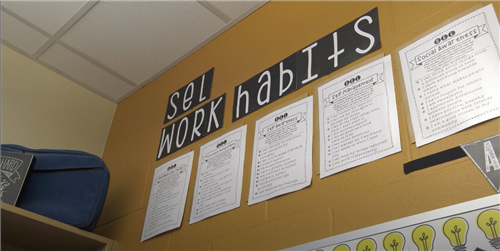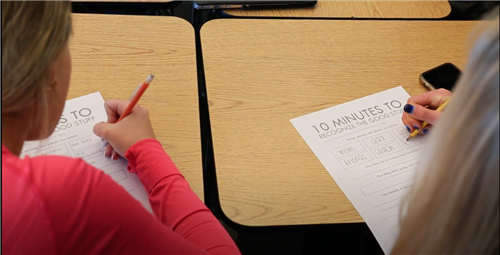Learning Connection
Page Navigation
Social-emotional learning is integrated into the lives and academics of Blue Valley students
Students walking into Kelly Lamp’s class are instantly greeted by their teacher who offers a bright, “Hello” and students return the greeting.
Lamp’s fourth grade class at Wolf Springs Elementary are asked in the mornings to mark their daily attendance and on Mondays, they write down their commitment for the week.
Students place their belongings in their assigned cubbies and are encouraged to greet their classmates.
After completing an activity, Lamp’s students gather in a circle on the carpet as their teacher conducts their daily morning meeting.
Lamp starts by sharing a quote followed by an affirmation. She states the affirmation then asks her students to repeat it, encouraging them to say it a second time so they truly believe it.
After a quick discussion about what national day falls on that particular day, Lamp moves on to the social-emotional learning skill the class is focusing on that week.
One week the class could be learning about relationship building and the next could be about recognizing their strengths.
Many of these activities Lamp incorporates into her students' morning routine, and at all hours of the school day, are social-emotional learning skills.
Social-emotional learning (SEL) is the process of teaching and learning life skills that help individuals to develop a positive sense of identity.
Every Blue Valley student is learning SEL skills that are intertwined into and complement their academic learning.
“Students learning social-emotional skills is so big because it’s teaching them not only how to be students in an academic environment but it’s teaching them how to be good people,” Lamp said.
SEL skills amplify students' abilities to learn academic skills while simultaneously teaching them essential life skills.
“It’s all the skills like time management, being able to be aware of themselves in situations, recognizing their strengths, being able to focus on the task at hand,” Lamp said.
Blue Valley focuses on five SEL pillars — self-awareness, social awareness, self-management, relationship skills and responsible decision making.
Learning these skills sets students up for success, Lamp said.

SEL and academics go hand-in-hand
Social-emotional learning works alongside academics. SEL helps individuals develop prosocial skills leading to effective communication, interpersonal and intrapersonal relationships.
They are the skills that help people set goals and turn them into a reality, allow for the development of empathy, see the world through others’ perspectives and be successful members of society.
“Social-emotional learning is fundamental to everything that we do,” said Dr. Kelly Wessel, Blue Valley’s director of professional learning.
The development of SEL skills makes learning academic skills a smoother process. A student working to solve a complex schoolwork problem needs additional layers that are deeper than cognitive skills.
Wessel said students need to be able to persevere when they become frustrated with the problem, have the confidence to know they can accomplish the assignment and have the intrinsic motivation to not give up.
SEL also teaches students how to manage their emotions and recognize what their emotion is tied to.
“There are all these other skills we are working on while we are also working on those academic and cognitive skills,” Wessel said. “These skills get developed in K-12, or even before that, in a much lower-stakes environment when their frontal lobes are still developing.”
The Kansas State Board of Education in 2012 adopted the Kansas social, emotional and character development model standards with the expectation that schools teach these skills alongside academic standards. SEL is also a component of Blue Valley’s accreditation process.
SEL teaches basic level life skills to all students such as learning how to stand in a line and follow the line leader or how to use your voice to state your opinion respectfully.
“Students are developing healthier attitudes, they develop stronger relationships with others,” Wessel said. “They can maintain positive relationships with others and build and maintain relationships through conflict.”
Some of the long-term benefits of SEL are academic performance and the development of skills students can carry with them throughout their lives.
The goal is that students develop SEL strategies and realize it’s a lifelong journey.
“We want to use these strategies alongside the academics so that we can help them see these are also the strategies that help you focus in school and deal with things that are going to happen to you in life,” Wessel said.
Families can support the SEL skills their kids are learning at school by collaborating with teachers.
Teachers might be using certain language at school that families can incorporate into their home lives so when reinforcing skills, kids are hearing the same words and phrases. Modeling good SEL is another way families can support the skills.
“Kids are always watching us and they will mimic those behaviors,” Wessel said. “If we’re not aware of our strengths and opportunities for improvement in some of these SEL skills at home then that can be something else families can do.”

SEL is integrated at all grade levels
Teaching social-emotional learning looks different at the elementary, middle and high school grade levels.
Kindergartners might focus on self-awareness, learning how to sit on a carpet during circle time and keeping their hands in their lap.
Relationship building and self-management sharply come into focus in middle school.
“Developmentally, when you get to middle school, the influence of your peers is going to be a bigger factor in your decision making than perhaps your thoughts of what you think you should do or what’s right or wrong,” Wessel said.
High school students continue to build on the skills they learned in elementary and middle school, but the focus shifts to more complex self-regulation skills, increasing independence and prosocial skills.
Katherine Koplik, a junior at Blue Valley North, said many of her classes incorporate SEL into lessons. Koplik has learned how to work in a team, develop professionalism, how to set boundaries and process emotions.
“My favorite thing we do in the district is daily check-ins in the classroom where they do a daily question or a mood meter. I feel like those tend to be a much more positive classroom culture.”
A social-emotional learning activity Blue Valley West high schoolers recently participated in was expressing gratitude and the benefits of telling a friend or loved one why they are grateful for that person.
Students watched a short video then reflected on the positive aspects of their life and the important people in their lives who have impacted them.
Lauren Garcia, a Blue Valley West history teacher, said SEL is important as standalone lessons but also when it’s naturally integrated into the curriculum.
When Garcia teaches AP macroeconomics and AP microeconomics, she talks with her students about utility and usefulness.
“When we talk about utility maximization and what brings us the most satisfaction, we’ve talked about love tanks and how we express love and how we receive love,” Garcia said. “I think our juniors and seniors find it fascinating and I think that they really understand utility a whole lot better after those conversations.”
Even in classes that don’t feel emotionally based, students and teachers are having conversations about SEL topics like resiliency and self-regulation.
“I think those skills carry and hopefully our students can take those forward when they graduate from here, and they can apply those in college or careers and beyond and that they help them become happy and successful adults,” Garcia said. “I think that’s really the measure of success we are all striving for these kids to achieve.”

